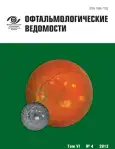THE TEAR FLUID QUALITATIVE CHARACTERISTIZATION IN PATIENTS AFTER LACRIMAL GLAND EXCISION
- 作者: Steshenko O.N.1, Mitichkina T.S.2
-
隶属关系:
- Russian Medical Academy of Postgraduate Education
- Federal State Budgetary Institution “Research Institute of Eye Diseases” of Russian Medical Academy
- 期: 卷 6, 编号 4 (2013)
- 页面: 46-50
- 栏目: Articles
- URL: https://journals.rcsi.science/ov/article/view/364
- DOI: https://doi.org/10.17816/OV2013446-50
- ID: 364
如何引用文章
全文:
详细
作者简介
Olga Steshenko
Russian Medical Academy of Postgraduate Education
Email: steshenko.ol@yandex.ru
aspirant. Department of Ophthalmology
Tatyana Mitichkina
Federal State Budgetary Institution “Research Institute of Eye Diseases” of Russian Medical Academy
Email: steshenko.ol@yandex.ru
PhD, senior scientific researcher of refraction department
参考
- Бржеский В. В., Сомов Е. Е. Роговично-конъюнктивальный ксероз (диагностика, клиника, лечение). - СПб: Левша, 2003. - 157 с.
- Егорова Г. Б., Новиков И. А. Тиаскоп параболический. Патент на полезную модель № 121434 от 23.05.2012 г.
- Егорова Г. Б., Новиков И. А., Митичкина Т. С. Совершенствование и оценка возможностей метода тиаскопии // Вестн. офтальмологии. - 2011. - Т. 127. - С. 35-39.
- Chen Z. Y., Liang Q. F., Yu G. Y. Establishment of a rabbit model for keratoconjunctivitis sicca // Cornea. - 2011. - Vol. 30, N 9. - P. 1024-1029.
- Craig J. P., Singh I., Tomlinson A. et al. The role of tear psychology in ocular surface temperature // Eye. - 2000. - Vol. 14, N 4. - P. 635-641.
- Economidis I., Tragakis M., Mangouritsas N., Papademetriou D. Keratoconjunctivitis sicca following excision of a dermolipoma of the lacrimal gland // Ann. Ophthalmol. - 1978. - Vol. 10, N 9. - P. 1273-1278.
- Elliot A. J. Lacrimal hyposecretion // Can Med Assoc J. - 1958. - Vol. 79, N. 5. - P. 371-378.
- Fujishima H., Toda I., Yamada M. et al. Corneal temperature in patients with dry eye evaluated by infrared radiation thermometry // Br. J. Ophthal. - 1996. - Vol. 80, N 1. - P. 29-32.
- Gilbard J. P., Rossi S. R., Gray K. L. et al. Tear film osmolarity and ocular surface disease in two rabbit models for keratoconjunctivitis sicca // Invest. Ophthalmol. Vis. Sci. - 1988. - Vol. 29, N. 3. - P. 374-378.
- Gilbard J. P., Rossi S. R., Gray K. L. A new rabbit model for keratoconjunctivitis sicca // Invest. Ophthalmol. Vis. Sci. - 1987. - Vol. 28, N. 2. - P. 225-228.
- Gilbard J. P., Rossi S. R., Gray K. L., Hanninen L. A. Natural history of disease in a rabbit model for keratoconjunctivitis sicca // Acta Ophthalmol. - 1989. - Vol. 192. Suppl. - P. 95-101.
- Goto E., Tseng S. C. Kinetic analysis of tear interference images in aqueous tear deficiency dry eye before and after punctal occlusion // Invest Ophthalmol Vis Sci. - 2003. - Vol. 44, N. 5. - P. 1897-1905.
- Kamao T., Yamaquchi M., Kawasaki S. et al. Screening for dry eye with newly developed ocular surface thermographer // Am. J. Ophthalmol. - 2011. - Vol. 151, N. 5. - P. 782-791.
- King-Smith P. E., Hinel E. A., Nichols J. J. Application of a novel interferometric method to investigate the relation between lipid layer thickness and tear filmthinning // Invest. Ophthalmol. Vis. Sci. - 2010. - Vol. 51, N. 5. - P. 2418-2423.
- Maitchouk D. Y., Beuerman R. W., Ohta T. et al. Tear production after unilateral removal of the main lacrimal gland in squirrel monkeys // Arch. Ophthalmol. - 2000. - Vol. 118, N. 2. - P. 246-252.
- Morgan P. B., Tull A. B., Efron N. Infared thermography of the tear film in dry eye // Eye. - 1995. - Vol. 9. - P. 615-618.
- Mori A., Oquchi Y., Okusawa Y. et al. Use of high-speed, high-resolution thermography to evaluate the tear film layer // Am. J. Ophthalmol. - 1997. - Vol. 124, N. 6. - P. 729-735.
- Purslow C., Wolffsohn J. The relation between physical properties of the anterior eye and ocular surface temperature // Optom. Vis. Sci. - 2007. - Vol. 84, N. 3. - P. 197-201.
- Scherz W., Dohlman C. H. Is the lacrimal gland dispensable? Keratoconjunctivitis sicca after lacrimal gland removal // Arch. Ophthalmol. - 1975. - Vol. 93, N 4. - P. 281-283.
- Singh G., Bhinder H. S. Comparison of noncontact infrared and remote sensor thermometry in normal and dry eye patients // Eur. J. Ophthalmol. - 2005. - Vol. 15, N. 6. - P. 668-673.
- The definition and classification of dry eye disease: report of the Definition and Classification Subcommittee of the International Dry Eye WorkShop (2007) // The ocular surface. - 2007. - Vol. 5, N. 2. - P. 75-92.
- Tomlinson A., Khanal S., Ramaesh K. et al. Tear film osmolarity: determination of a referent for dry eye diagnosis // Invest. Ophthalmol. Vis. Sci. - 2006. - Vol. 47, N. 10. - P. 4309-4315.
- Tsubota K., Kaido M., Yagi Y. et al. Diseases associated with ocular surface abnormalities: the importance of reflex tearing // Br. J. Ophthalmol. - 1999. - Vol. 83, N. 1. - P. 89-91.
- Yeh S., Song X. J., Farley W. et al. Apoptosis of ocular surface cells in experimentally induced dry eye // Invest. Ophthalmol. Vis. Sci. - 2003. - Vol. 44, N. 1. - P. 124-129.
- Zelichowska B., Rozycki R., Tlustochowicz M. et al. The usefulness of thermography in the diagnostics of dry eye syndrome // Klin. Oczna. - 2005. - Vol. 107, N. 7-9. - P. 483-487.
- Zhang Y. Q., Qian J., Yuan Y. F. et al. Tear film and lacrimal excretion changes after lacrimal gland tumor removal // Zhonghua Yan Ke Za Zhi. - 2013. - Vol. 49, N 1. P. 27-31.
- Zhou Y., Wang C. F., Jiang T. Expression of apoptosis related genes and changes of lacrimal functions in main lacrimal gland extirpation xerophthalmia model // Zhonghua Yan Ke Za Zhi. - 2007. - Vol. 43, N. 1. - P. 18-22.
补充文件







